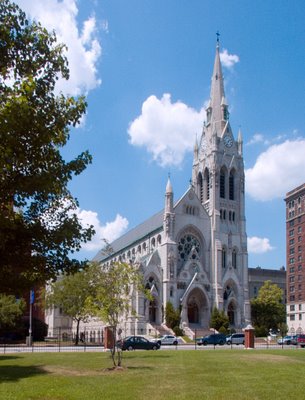
This is Saint Francis Xavier Church, which is both one of the university's chapels and a diocesan parish.
Construction of the church started in 1883 and it is modeled after the neo-Gothic, 19th century Cathedral of Saint Colman in Cobh, County Cork, Ireland. The interior of the church has been highly modified from its original state.
 In recent years, SLU President Father Lawrence Biondi, S.J., has directed a massive beautification program for the campus, and this clocktower and fountain is now a central focus.
In recent years, SLU President Father Lawrence Biondi, S.J., has directed a massive beautification program for the campus, and this clocktower and fountain is now a central focus.Like most American urban areas in the 1960s, the surrounding area lost population and business to the suburbs, while the crime rate soared. The campus was relatively scattered, since it did not have, strictly speaking, a 'campus', but was mixed among non-university buildings and streets. Walking between buildings became very dangerous at night, and the surrounding area was blight, with few nearby businesses or activities for the students.
By the early 1980s, the area was dreary and ugly, with rape and murder of students being far too common. There was even some talk of relocating the University to the suburbs.
Fr. Biondi's far better solution was to create a real campus from the existing patchwork of buildings, and to work with government and local business to revitalize the surrounding area. It has been proven to be a successful strategy.
The university purchased many buildings, especially those that fell between those it already owned, destroyed many vacant structures, closed off roads that ran through the campus, and put decorative and effective fencing around its perimeter, perforated with few, well-lit gateways.
Former roads were turned into landscaping, giving the campus an open, attractive appearance. Statuary (almost entirely secular, though), fountains, and flowers are everywhere, with a great emphasis on beauty. A once ugly urban area was transformed into a parklike setting.
Likewise, the area to the north of campus was revitalized, and includes the Grand Center arts and entertainment district. This area includes the Saint Louis Symphony Orchestra and the renovated Fox Theater, with its unusual Byzantine-Burmese hybrid interior.

These are former luxury hotels of the 1920s, later converted to dormitories.
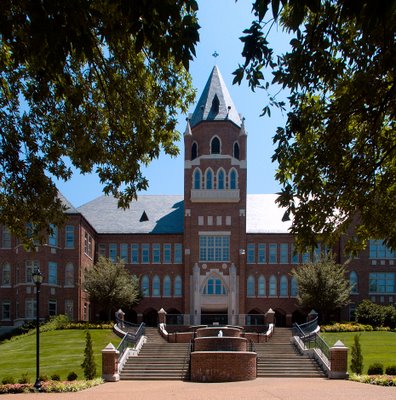 Cook Hall houses the business school.
Cook Hall houses the business school.SLU, along with nearly every Catholic college in the United States, decided to become more secular in the 1960s, supposedly in order to attract and not offend non-Catholic students. The teaching is now more 'vocational' instead of 'liberal arts'. However, secular colleges then began recruiting Catholic students. A reduction of 'parochialism' led instead to often destructive competition on a large scale, as well as a loss of Catholicity in the institutions and the students. Many smaller colleges failed and closed.
A note about secularization: If someone removes religious imagery from a university in order not to offend you—is that because you are a bigot and would be offended? Or were the iconoclasts themselves offended by the imagry? Also, in ancient Greece and Rome, the liberal arts were taught to free men, while the vocational arts were taught to slaves. Try to keep that in mind.
 Masonic temples coldly gaze at the University across Lindell Boulevard.
Masonic temples coldly gaze at the University across Lindell Boulevard.Freemasonry is the embodiment of Enlightenment Classical Liberalism. It rose in the aftermath of the bloody wars of the Reformation.
Historically, American Freemasonry dominated government, with many American Presidents being members, and have often been the majority in congress and the Supreme Court. Since the mid-19th century, a increasing numbers of Catholics in American government caused power struggles between the groups. Freemasons and Catholics here had been at each other's throats, starting with the attacks by the Nativists and Know-Nothings on the flood of Catholic immigrants in the 1850s, and continuing down until the 1950s Court decisions to deny public funding for Catholic schools. Throughout American history, Masonic participation in government far exceeds their numbers in society as a whole. The Masonic temples here, built subsequent to the university, were a warning and a threat. We are watching you!.
However, international Communism, the rise of Socialism in the United States during the New Deal, and Marxism's increasing dominance in the Democratic Party, caused a shift in political alliances. Remarkably, many old rivals became close allies. The famous 'Fusionism' of the 1950s, promoted by William F. Buckley, Jr. in his magazine National Review, politically allied the Freemasons and traditional Christians together in a new conservative movement. Young Catholics coming of age in the late 1970s and later generally followed this new conservatism, breaking with older Catholics who increasingly became open Marxists. Generally, this new conservatism has been strongly influenced by Catholic moral doctrine, leading many other conservatives to move towards Catholicism. A recent split in the American conservative movement is widening, however, between the Neo-Conservatives (who are also called Neo-Liberals) and the Traditionalists.
Directly across the street from the Masonic temples...
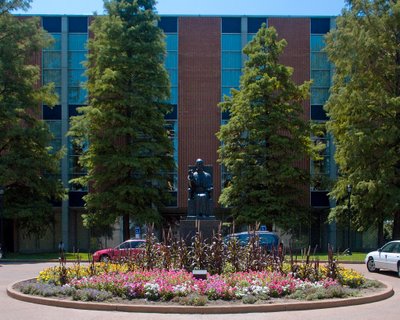 ...the Venerable Pope Pius XII looks back.
...the Venerable Pope Pius XII looks back.The statue is in front of a large library named for Pius XII. Besides books, it contains the Knights of Columbus Vatican Film Library, which is a microfilm version of
"The Vatican Library in Rome, known officially as the Biblioteca Apostolica Vaticana, is one of the outstanding libraries of the world and possesses among its treasures one of the richest collections of medieval and Renaissance manuscripts in the world, comprising some 70,000 manuscript codices. It is also one of the oldest continuous libraries in Europe..."Does anyone want to donate the time and money needed to get this document collection on the Internet?
"...the Vatican Film Library also from the 1950s extensively filmed Jesuit archival material relating to Jesuit activities in the New World from the Central Jesuit Archives in Rome and from provincial Jesuit archives in North and South America and the Philippines."
 SLU is overflowing with fountains, and flowers are planted extensively. It is a shame that the fountains are shut off during most of the school year, due to freezing weather, and there are very few plants that will flower in Saint Louis in January. But the campus is glorious during the warm months.
SLU is overflowing with fountains, and flowers are planted extensively. It is a shame that the fountains are shut off during most of the school year, due to freezing weather, and there are very few plants that will flower in Saint Louis in January. But the campus is glorious during the warm months.The campus was the location of the Camp Jackson Affair, which according to Wikipedia:
"The St. Louis massacre (sometimes referred to as the Camp Jackson Affair) was an incident in the American Civil War on May 10, 1861, when Union military forces clashed with civilians on the streets of St. Louis, Missouri, resulting in the deaths of at least 28 people and injuries to another 100. The affair polarized the border state of Missouri, leading many citizens to advocate secession and setting the stage for sustained violence between the opposing factions."This area was the site of a militia encampment, authorized by pro-Southern Governor Claiborne Jackson, which was suspected to be planning the capture of a U.S. Army arsenal in Saint Louis.
 The SLU campus is open and beautifully landscaped, and can be contrasted with nearby Washington University. The Wash U. campus is famous for its Gothic architecture (with some ugly Brutalist structures built around 1970), but is crowded and lacks attractive landscaping. Certainly, the architecture at Wash U. is generally superior to SLU, which has many uninspired modern buildings, but lacks a certain kind of natural touch.
The SLU campus is open and beautifully landscaped, and can be contrasted with nearby Washington University. The Wash U. campus is famous for its Gothic architecture (with some ugly Brutalist structures built around 1970), but is crowded and lacks attractive landscaping. Certainly, the architecture at Wash U. is generally superior to SLU, which has many uninspired modern buildings, but lacks a certain kind of natural touch.Perhaps the difference is due to the foundations of the two schools: Washington University has Puritan roots, and the Puritans had a rather, um, puritanical view of nature: they didn't love it as a part of Creation, but rather saw it merely as a resource; latter-day Puritans want to wall-off nature and keep it separate and untainted by a human presence. Generally, the traditional Catholic view of nature neither sees it as a resource for exploitation, nor as a pristine wilderness that is fouled by humans, but is something that should be close and delightful, while also respected due to its inherent dangers.

Cupples House was the mansion of Samuel Cupples, which dates from 1888 and was designed by architect Thomas B. Annan; both these men were Methodists. Cupples owned the massive Cupples Station warehouses in downtown Saint Louis, Missouri. This building is now an art gallery.
 The Saint Louis University Museum of Art, originally built in 1900 as the exclusive St. Louis Club. This Beaux Arts style building was designed by Arthur Dillon, who studied at the Massachusetts Institute of Technology and the École des Beaux-Arts in Paris. For a while, it was the headquarters of the F.W. Woolworth Company (which now has the unattractive name "Foot Locker Inc.")
The Saint Louis University Museum of Art, originally built in 1900 as the exclusive St. Louis Club. This Beaux Arts style building was designed by Arthur Dillon, who studied at the Massachusetts Institute of Technology and the École des Beaux-Arts in Paris. For a while, it was the headquarters of the F.W. Woolworth Company (which now has the unattractive name "Foot Locker Inc.")Among other exhibits, this houses the permanent Collection of the Western Jesuit Missions, a magnificent collection of artifacts of the Jesuit missions to the American west.

This campus has plenty of modern buildings, of which this is one example.

Another former residence on campus.

The campus is surrounded with fencing, with gateways such as this. The two figures seen here wear white religious habits.
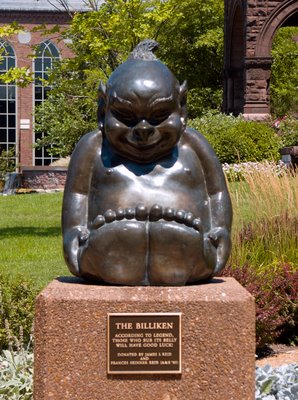
The Billiken is the campus mascot. It originally was a toy similar to the Kewpie-doll.
 WHERE THE RIVERS MEET DE SMET BEGAN
WHERE THE RIVERS MEET DE SMET BEGANThis depicts the Missouri and Mississippi Rivers, as well as Fr. De Smet preaching to Indians. Generally, the Indians had high respect of Men of God. If you read the accounts of the early Catholic missionaries, we find the Indians to be extremely gracious hosts, with very little evidence of hostility, who developed close bonds with the Europeans. There was also great mutual admiration and respect between both sides, which is far different than the standard version of the story, which called for the elimination of the Indian as a part of American destiny.
We often hear the distinction in the old journals between civilized and savage tribes. These terms are quite politically loaded nowadays. The traditional distinction was simple. If a tribe lived in a town, they were civilized. If they were of the forest (French: sauvage, from Latin, silvaticus), they were savage. Being either civilized or savage had nothing to do with being refined or brutal. Modern day civilized Americans are often beastly, while many of the savage Indians befriended by the missionaries were gracious.

Du Bourg Hall.
Louis William Du Bourg was consecrated Bishop of Louisiana and the Two Floridas in 1815. He quickly decided to move his cathedral from New Orleans to Saint Louis, due to the hostile and secularized way of life in the Big Easy.
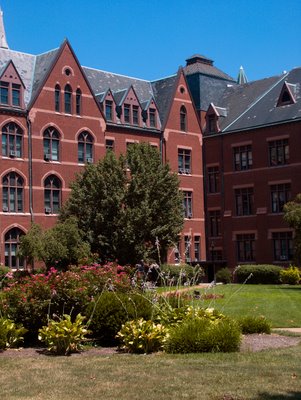
Another view of Du Bourg Hall.
There is also a Bishop Du Bourg High School in Saint Louis.

The Continental Life building, also known as the "Superman Building", due to its resemblance to a building featured in an old television series. Not so long ago, you could have bought this for less than $200,000, because it was empty for decades and violated plenty of building codes. It was built in the late 1920s and was the most desirable business address until the mid-1950s when new high-rise buildings went up in downtown Saint Louis and in nearby Clayton. SLU helped redevelop this into apartments.
 Jesuit Hall, where members of the Society of Jesus reside. There is also a Dominican friary in this building; the two religious orders keep their own chapels, but share a common dining room.
Jesuit Hall, where members of the Society of Jesus reside. There is also a Dominican friary in this building; the two religious orders keep their own chapels, but share a common dining room.A dozen Belgian Jesuits came to Saint Louis in 1823, building a seminary and Indian boy's school in nearby Florissant, Missouri. Father Peter J. Verhaegen, S.J., became president of what was to become SLU in 1829, and the Jesuits received ownership in 1832. This was the second Jesuit college in the U.S., and was just one more of hundreds of schools already operated by the order worldwide.
Since Saint Louis was the hub of the fur trade, as well as point of departure for adventurers and frontiersman, Jesuit missionaries followed the trails west to the relatively unknown interior. The courage of the Jesuit missionaries was remarkable, and their missions very successful. To this day, half of all American Indians are Catholic. Now we have to send missionaries to the White Man.


I have been in the Scottish Rite "Cathedral." My wife used to teach dance and they would have competitions in that building. It is creepy.
ReplyDeleteIs SLU showing any signs of recovering its Catholicity? I was wondering if the JPII generation is having an impact there.
ReplyDeleteArgent,
ReplyDeleteThere are signs of improvement, especially among the students and younger faculty. It still has a way to go.
Just a quick comment, the luxury hotels of the 1920s aren't dormitories, they're apartment buildings. Many, many students live there, but they're not owned by the University.
ReplyDeleteAnd, yes, as a 2006 alumnus of SLU, there is a great deal of Catholic revival going on at the University. Good things are happening, but slowly.